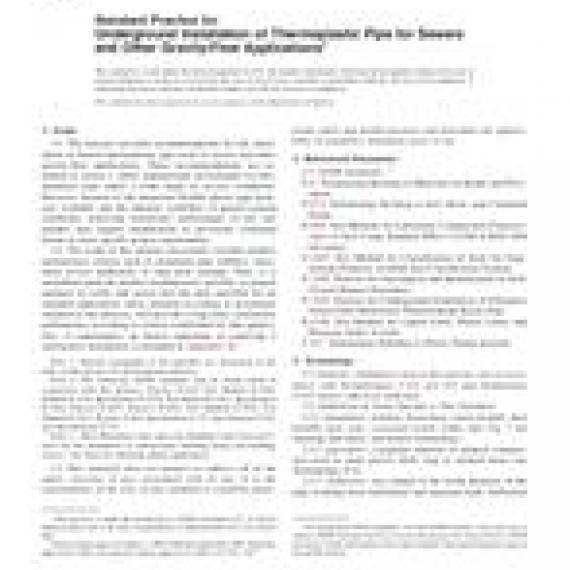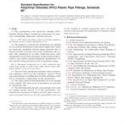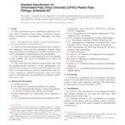-
 1xGMW17941
$46.20
1xGMW17941
$46.20 -
 1xGMW17362
$46.20
1xGMW17362
$46.20 -
 1xISO 3630-5:2020
$30.60
1xISO 3630-5:2020
$30.60 -
 1xISO 10434:2020
$83.25
1xISO 10434:2020
$83.25 -
 1xRTCA DO-253C
$123.75
1xRTCA DO-253C
$123.75 -
 1xGMW17939
$46.20
1xGMW17939
$46.20 -
 1xGMW14566
$50.40
1xGMW14566
$50.40 -
 1xRTCA CTF-5
$117.00
1xRTCA CTF-5
$117.00 -
 1xGMW16050
$139.30
1xGMW16050
$139.30
No products
ASTM D2321-05
ASTM D2321-05 Standard Practice for Underground Installation of Thermoplastic Pipe for Sewers and Other Gravity-Flow Applications
standard by ASTM International, 08/01/2005
Full Description
1.1 This practice provides recommendations for the installation of buried thermoplastic pipe used in sewers and other gravity-flow applications. These recommendations are intended to ensure a stable underground environment for thermoplastic pipe under a wide range of service conditions. However, because of the numerous flexible plastic pipe products available and the inherent variability of natural ground conditions, achieving satisfactory performance of any one product may require modification to provisions contained herein to meet specific project requirements.
1.2 The scope of this practice necessarily excludes product performance criteria such as minimum pipe stiffness, maximum service deflection, or long term strength. Thus, it is incumbent upon the product manufacturer, specifier, or project engineer to verify and assure that the pipe specified for an intended application, when installed according to procedures outlined in this practice, will provide a long term, satisfactory performance according to criteria established for that application. A commentary on factors important in achieving a satisfactory installation is included in . Specific paragraphs in the appendix are referenced in the body of this practice for informational purposes.
Note 1
The following ASTM standards may be found useful in connection with this practice: Practice D 420, Test Method D 1556, Method D 2216, Specification D 2235, Test Method D 2412, Specification D 2564, Practice D 2657, Practice D 2855, Test Methods D 2922, Test Method D 3017, Practice F 402, Specification F 477, Specification F 545, and Specification F 913.
Note 2Most Plumbing Codes and some Building Codes have provisions for the installation of underground "building drains and building sewers." See them for plumbing piping applications.
This standard does not purport to address all of the safety concerns, if any, associated with its use. It is the responsibility of the user of this standard to establish appropriate safety and health practices and determine the applicability of regulatory limitations prior to use.


































